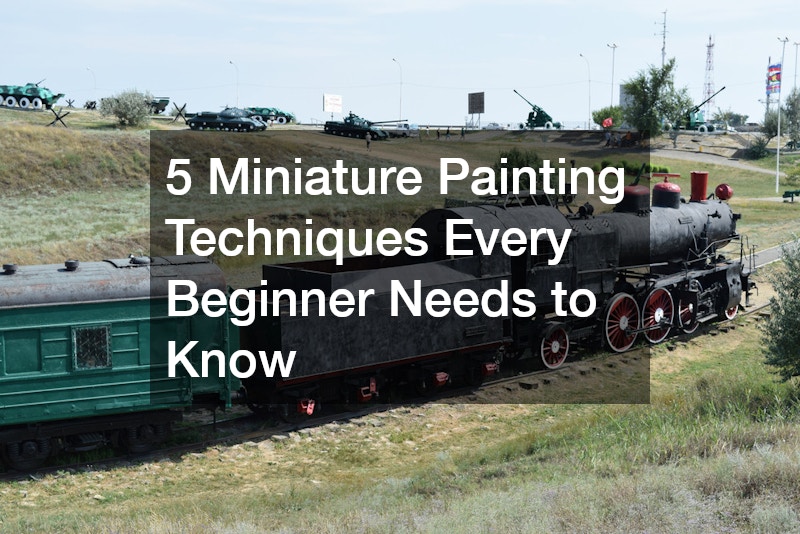
5 Miniature Painting Techniques Every Beginner Needs to Know

Getting into miniature painting can be both exciting and daunting. With so many tools and techniques out there, it can be hard to know where to begin. This guide focuses on five essential techniques that will give your miniatures a clean, polished look. Whether you’re painting for board games, Dungeons & Dragons, or wargames like Warhammer, these methods will help you improve your skills while making your models stand out.
1. Base Coating: The Foundation of Your Miniature
Base coating is the first step to any successful miniature paint job. It involves applying a solid layer of color over your primed miniature, forming the foundation for all other painting techniques.
This technique is important because it ensures that later layers of paint adhere properly and appear vibrant. Without a smooth base coat, your miniatures may look uneven, and details can be lost.
- Tools: Use a medium or large synthetic brush to apply base coats, as it covers larger areas quickly without sacrificing control. Inexpensive brushes, such as those found in hobby stores, work well for this purpose.
- Paint Consistency: Thin your paints with a bit of water or a medium like Lahmian Medium (from Citadel) to prevent thick layers from obscuring details. Two thin coats are often better than one thick coat for smooth coverage.
- Color Selection: Choose a base coat color that complements your intended final scheme. Darker colors are easier to work with when layering up to lighter tones.
2. Layering: Building Depth and Highlights
Layering is one of the most versatile and commonly used techniques in miniature painting. It involves building up highlights and shadows by applying progressively lighter (or darker) shades of paint over your base coat. This technique helps create depth and realism, making your models look more dynamic and three-dimensional. Layering also gives you greater control over where light and shadow fall on the model.
- Tools: A fine detail brush, such as a size 0 or 1, will help you apply paint accurately without affecting surrounding areas. A wet palette can keep your paints for miniatures thin and prevent them from drying out too quickly.
- Technique: Start with a mid-tone layer, and then gradually apply lighter tones to areas that would naturally catch the light. For shadows, apply darker tones in the recesses.
- Blending Colors: On your wet palette, mix small amounts of adjacent colors to create smoother transitions between layers. For example, when layering red, create mid-tones by blending red with orange for highlights or black for shadows.
3. Wet Blending: Smooth Transitions Between Colors
Wet blending is a more advanced technique that allows you to create smooth transitions between two different colors while the paint is still wet. This is especially useful for larger surfaces, such as cloaks, wings, or armor plates. The result is a gradient effect that looks natural and fluid, but it does require some speed and confidence since acrylic paints dry quickly.
- Tools: You’ll need a wet palette to keep your paints moist and blendable, as well as larger, softer brushes that can help blend colors smoothly.
- Paint Selection: Use highly pigmented paints for miniatures so that they remain vibrant during blending. Citadel’s “Layer” range or Vallejo’s “Model Color” line works well.
- Technique: Start by applying two colors side by side on the miniature, and then use a clean, damp brush to gently blend the two colors together. Go back and forth to smooth out harsh lines. Practice on larger surfaces before attempting this on smaller, more detailed areas.
4. Dry Brushing: Quick and Easy Highlights
Dry brushing is a popular technique for adding quick highlights to raised surfaces, making it ideal for textures like fur, chainmail, and rough stone. It’s one of the easiest techniques to learn and can give impressive results with minimal effort. Dry brushing works by loading a brush with paint, then removing most of the paint before gently brushing it across the surface to leave a fine layer on raised details.
- Tools: Use stiff, flat brushes like makeup brushes or specialty dry brushes. Avoid using your detail brushes, as dry brushing can quickly wear them out. Cheap brushes from art supply stores work great for this.
- Paint Application: After loading your brush with paint, remove most of it by wiping it on a paper towel until the brush appears almost dry. Then, lightly sweep the brush across the raised surfaces of the miniature.
- Colors: Light shades such as white, bone, or metallic colors are great for dry brushing as they bring out the contrast between shadows and highlights. Experiment with layering multiple dry brush colors for more complex results.
5. Edge Highlighting: Crisp, Clean Detail
Edge highlighting is a more precise technique that helps define the edges of your miniature, making details pop and creating sharp, clean lines. It’s often used on armor, weapons, and other hard surfaces. While edge highlighting can take practice to master, it is a simple way to make your miniature look more professional by creating contrast between surfaces.
- Tools: A fine detail brush with a sharp point is crucial for edge highlighting. Brushes like the Winsor & Newton Series 7 size 00 or 0 are ideal. Make sure your paint is thin but not too watery for clean lines.
- Technique: Instead of using the tip of the brush, drag the side of the brush along the edges of the miniature to create a smooth, even highlight. Be selective about which edges you highlight to avoid making the model look too cartoonish.
- Colors: Use a slightly lighter shade of the base color for subtle edge highlights, or go for a stark contrast (such as white on black) for a more dramatic effect.
Final Thoughts
Mastering these five miniature painting techniques—base coating, layering, wet blending, dry brushing, and edge highlighting—will significantly improve your ability to create eye-catching and realistic models. By practicing these foundational skills, you’ll develop a better understanding of how to work with paints for miniatures and gain more control over the look of your figures. Don’t rush the process; take the time to refine each technique and watch as your minis start to come to life.
.





No Comment